From How-To Guides To Market Trends: 17 Blog Ideas For Real Estate To Attract More Clients

Running a real estate blog that you update regularly with fresh content is one of the best ways to strengthen your online presence.
Blogging helps your real estate business appear when people search for your services on Google, and having a blog increases your chances of ranking higher in search results by 434%.
Interestingly, 70% of people say they would rather learn about a company through blog articles rather than through advertisements, highlighting just how impactful blogging can be.
However, with more than 7.5 million blog posts being published every day, how can you make sure yours stands out and generates leads for your business?
In this guide, we’ll explain blogging and its benefits for your real estate business. We’ll also share some top real estate blog ideas you can try out and walk you through how to create excellent content.
What Is a Real Estate Blog?

A blog is a dedicated space on your website where you share helpful, relevant content about real estate.
The goal is simple: to educate, inform, and connect with potential clients by offering practical real estate tips, timely updates, and valuable insights.
When done well, your blog becomes more than just a marketing tool. It improves your visibility in search results, generates new leads, and positions your business as a trusted expert that clients can rely on for guidance.
What Are the Benefits of Blogging for Your Real Estate Business?

Now that you know what a blog is, let’s dive into the benefits of blogging for a real estate professional like yourself:
Increases online visibility and reach
Blogging regularly about relevant topics is one of the most effective ways to improve your website’s search engine optimization (SEO). Each post gives you a chance to target specific keywords that potential clients are searching for on Google, which helps your site rank higher in search results.
That added visibility brings in more organic traffic, which is when people find real estate websites naturally through search engines. In fact, businesses that blog generate twice as much organic traffic as those that don’t.
You can also use your blog to reach the exact type of clients you want. For instance, writing about luxury properties, first-time buyer tips, or commercial real estate can help you connect with different types of buyers.
Establishes credibility and authority in the real estate industry
A blog showcases your expertise in the field, demonstrating your knowledge of:
- The local market.
- Industry trends.
- The property buying and selling real estate journey.
When you consistently provide your readers with valuable insights, potential and existing clients see you as a trustworthy and knowledgeable source of information.
Prospective clients are more likely to trust and engage with a real estate professional or business that offers helpful, transparent advice.
Helps build a strong personal brand
If you’re a real estate agent or broker, blogging allows you to highlight your personality and approach to the role, helping clients feel more connected to you. This connection can set you apart from other real estate agents, making your brand more memorable.
Generates leads
Each blog post is a potential lead-capture tool. SEO leads have a 14.6% close rate, while outbound leads, such as direct mail or print advertising, only have a 1.7% close rate. Companies with blogs produce an average of 67% more leads monthly than those that don’t blog.
Keeps clients engaged
Blogging also keeps past clients engaged and reminds them of your expertise. When they’re ready to buy or sell again (or know someone who is), you’ll likely be top-of-mind. Blogs that target common questions or local developments can easily be shared by previous clients, increasing your likelihood of referrals.
Supports social media and email marketing efforts
Blog posts make excellent social media content, offering valuable information to your followers. Sharing blog posts on platforms like Facebook, LinkedIn, and Instagram drives traffic back to your website and reinforces your position as an expert.
This is important because 92% of bloggers drive traffic to their blogs via social media content, and doing the same can help you expand your reach to audiences who may not find you through search engines.
Real estate blogging also provides fresh, relevant content to share with your email subscribers. Monthly or weekly newsletters featuring your latest blog posts offer consistent touchpoints to stay in contact with potential clients and help them remember your brand.
Helps educate and empower clients
Real estate transactions involve multiple steps, which can often overwhelm buyers and sellers. Blogs on topics like “Understanding Closing Costs” or “The Home Inspection Process Explained” provide practical advice and enable clients to make informed decisions, potentially simplifying your role in the process.
More than 45% of businesses say analyzing and addressing customer questions in blog posts boosts their rankings. By addressing frequently asked questions (FAQs) through blog content, you reduce the time you’d spend answering repetitive questions.
For example, posts about financing options, market conditions, or local tax incentives can educate your clients, making interactions more productive and focused on the advanced stages of the real estate sales process.
Builds long-term organic traffic
Many real estate topics are evergreen, meaning they stay relevant for months or even years. Posts about “How to Buy Your First Home” or “Tips for Staging a Home for Sale” continue to attract visitors over time, building long-term traffic to your website that can convert visitors into leads.
Each blog post can drive traffic independently, giving you multiple ways to attract clients to your site. The more quality posts you create, the more opportunities you have for traffic, which can multiply your leads significantly without additional advertising costs.
Helps you stand out from the competition
Many real estate professionals still overlook the benefits of blogging, relying solely on traditional marketing. Investing in high-quality content positions you as a thought leader in your area and sets you apart from competitors who may not provide the same level of valuable content online.
17 Real Estate Blog Topics to Get You Started

As you can see, blogging has massive benefits, but where do you start? Below are some real estate blog post ideas and topics you can use to inspire your blog posts.
1. A first-time homebuyer’s guide
Many potential clients are first-time homebuyers who may be intimidated by the buying process. A first-time homebuyer’s guide could outline the entire process, from pre-approval to closing, breaking down each step.
Under this topic, you could also cover:
- Financing tips.
- The role of a real estate agents.
- Understanding home inspections.
- Tips on saving for a down payment.
This blog post from The Jim Allen Group takes readers through the entire process of buying a home for the first time, providing in-depth advice and tips from finding the right agent to securing financing:

2. How to stage your home to sell faster
How-to articles and lists are the most popular blog post formats, and they rank well. One idea is to write a guide on how sellers can stage their homes to sell them faster.
You could include:
- Tips for each room.
- Staging trends.
- Affordable DIY staging ideas.
- Insights into the psychology of home staging.
Check out the guide below by North of NYC that provides readers with home staging tips to help them sell their property faster. This is a comprehensive blog post with loads of expert advice that positions the company as an authority on the topic:

3. Understanding real estate housing trends
Buyers and sellers both want to understand local market trends. Tailoring this content to specific neighborhoods or regions gives it local relevance, positioning you as an expert in the area.
Consider adding:
- An analysis of property prices over time.
- Supply and demand in the local market.
- Seasonal real estate trends.
- Forecasts for future developments.
- Local crime rates.
Below is a blog post from ROI Properties that covers luxury housing market trends in the U.S. It gives readers valuable insight into home sales, prices, and housing supply:

4. A moving checklist: From packing to settling in
Moving is a stressful process, and a checklist can simplify it for your clients, making your blog a valuable resource even post-transaction.
Potential ideas to include could be:
- Packing timelines.
- Organizing and labeling tips.
- Tips on moving with pets.
- How to handle utilities and address changes.
The guide below from Century 21’s real estate blog includes moving tips for buyers. It covers everything from disconnecting utilities to measuring doorways and furniture:

5. Exploring the best neighborhoods in [City]
Many buyers start their research by exploring neighborhoods, especially when moving to a new area. In a blog post, you could highlight:
- Different neighborhoods.
- Details on schools, amenities, and local parks.
- The nightlife.
- Safety.
- Commuting options.
- Local events.
- An interesting local business.
A guide like this provides valuable insights and showcases your local market insights and knowledge.
Below is an example of a good local blog post by Prevu highlighting the best neighborhoods in Manhattan. This article showcases their unique knowledge of the region they operate in:
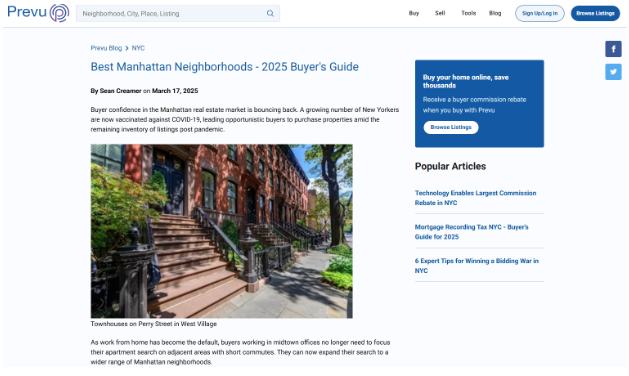
6. What to expect during a home inspection
Many first-time buyers may be unsure of what a home inspection involves, so explaining the process can ease their anxieties and help them prepare for it.
You may want to include:
- Typical areas inspected.
- Common issues found.
- How to prepare a home for inspection.
- What happens if issues are identified.
In the blog post below, Own Real Estate shares a detailed guide on what buyers and sellers can expect during a home inspection, potentially easing some of the anxiety around this step in the transaction process:
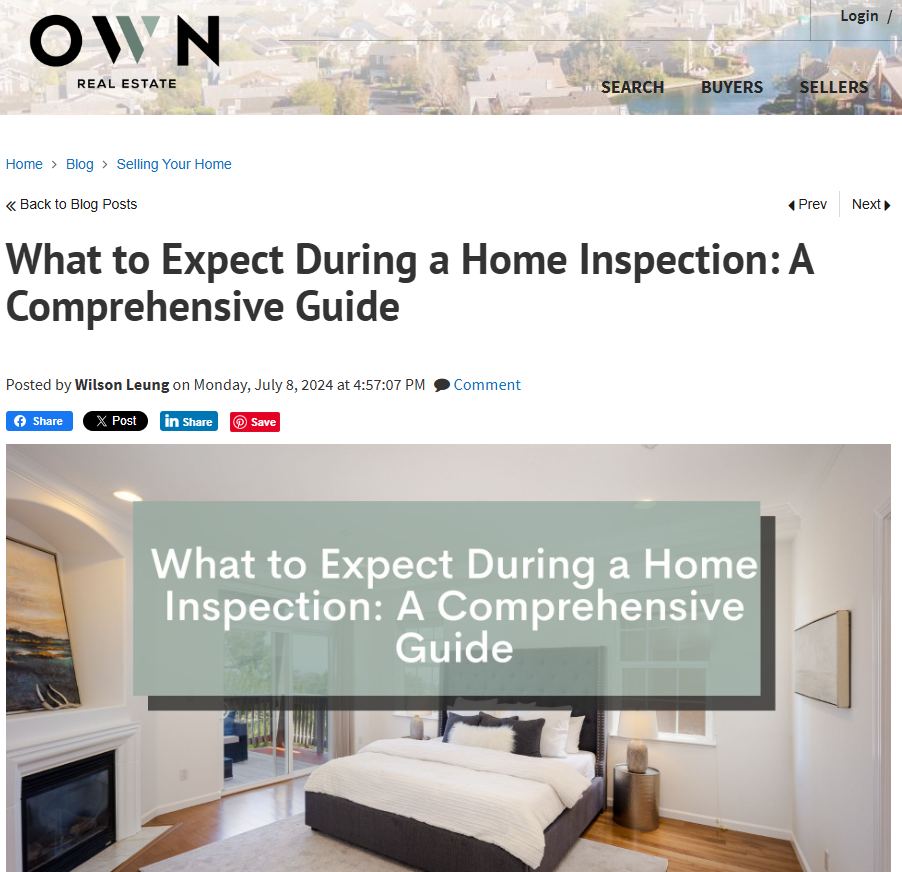
7. Top mistakes to avoid when selling your home
Sellers want to avoid pitfalls that could delay a sale or reduce profits, so providing tips on achieving this positions you as an advocate for their best interests.
Consider discussing the following common problems:
- Overpricing.
- Neglecting repairs.
- Poor staging.
- Failing to disclose important details.
- Information on working with agents versus selling solo.
The blog post below from The Mardona Group Inc. covers six mistakes sellers should avoid. It includes a helpful infographic to make the article visually dynamic and covers a wide range of pointers that give readers tangible value:

8. Real estate investment 101: A beginner’s guide
Investment properties are increasingly popular, but they can be complex. A guide like this appeals to aspiring real estate investors who may be unsure where to start. Writing a blog post about real estate investing helps you target investors if that’s your target audience.
You could include:
- Types of investment properties.
- Calculating return on investment (ROI).
- Financing options.
- Common pitfalls for new investors.
Below is an example of a real estate investment-focused blog post from Partners Real Estate on investing in commercial properties:

9. How to improve your home’s curb appeal on a budget
Many homeowners want to increase their property’s appeal without a large budget, as people looking to sell their home often have limited funds. Having a presentable property has an impact on its value, and this article could offer practical advice for easy, low-cost upgrades.
Potential topics you could cover include:
- Simple landscaping tips.
- Exterior paint colors.
- Lighting ideas.
- DIY repairs.
- Small upgrades that make a big impact.
In the blog post below, written by real estate agent Lynn Pineda from Keller Williams, she provides tangible tips on how sellers can improve their home’s value:

10. Tips for buying a home in a competitive market
Buyers in a competitive market can benefit from expert strategies to make their offers stand out. In an article like this, you could address their frustrations and offer actionable tips.
Consider including:
- How to write a winning offer.
- Tips for bidding wars.
- The advantages of pre-approval.
- When to make concessions.
In the example below, Farrel Realty & Property Management shares six tips on how to buy a home in a competitive market. This comprehensive guide covers everything from pre-approvals to considering contingencies:

11. Understanding property taxes in [City/County]
Property taxes can be confusing, especially for first-time buyers. So, a local guide could help clarify these costs and show you’re well-versed in your area’s specifics.
In the post, you could cover:
- How taxes are calculated.
- Available tax exemptions.
- Changes in tax rates.
- How taxes affect overall homeownership costs.
In the example below, Mark Spain Real Estate shares tangible information and advice to readers about property taxes:

12. How to save for a down payment faster
Many buyers, especially younger ones, are looking for ways to save for a down payment. You could write blog posts where you provide practical strategies to help them reach this goal.
Consider including:
- Tips on budgeting.
- Opening a high-yield savings account.
- Reducing expenses.
- Down payment assistance programs.
In this blog post by Stonefield Homes, the real estate brokerage shares its top tips to help readers save for a down payment faster. It offers actionable strategies and provides information on down payment assistance programs:
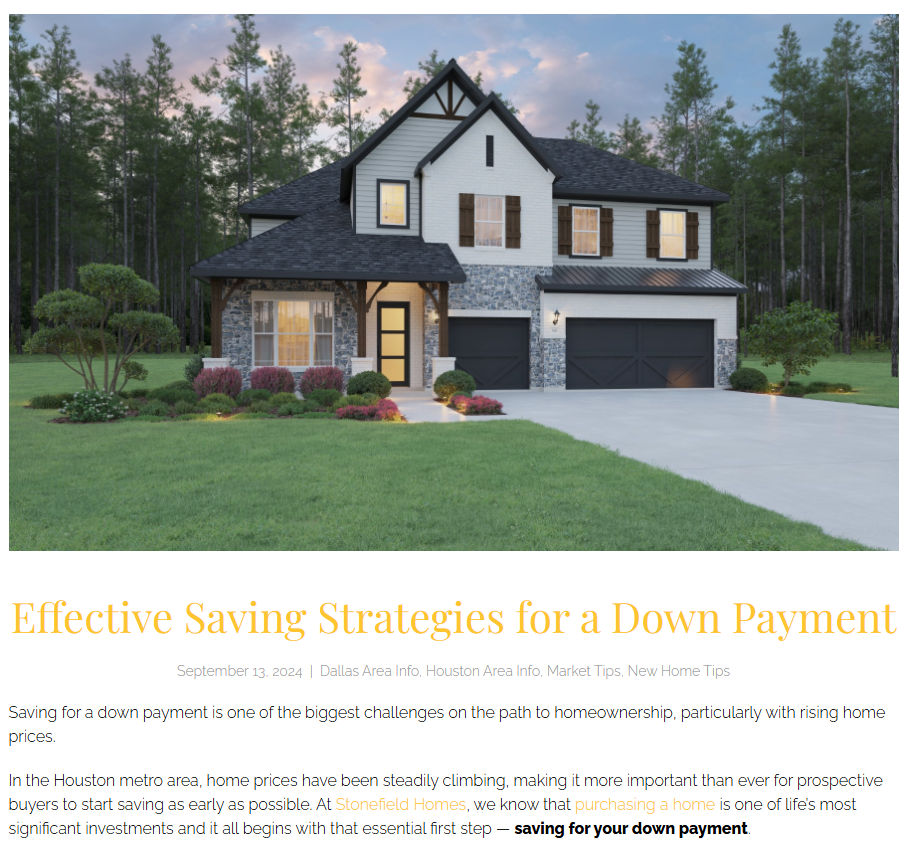
13. Home renovations that add value
Homeowners considering renovations want to know which projects will boost their home’s value the most. This topic positions you as a trusted source for making sound investment decisions.
You could include the following in your article:
- Kitchen and bathroom upgrades.
- Energy-efficient improvements.
- Smart home technologies.
- Renovation ROI.
In the example below, realtor Anita Clark from Coldwell Banker Access Realty writes about creating a budget for home renovations. This article provides valuable information to homeowners who may be interested in renovations and want to know how to save for them:
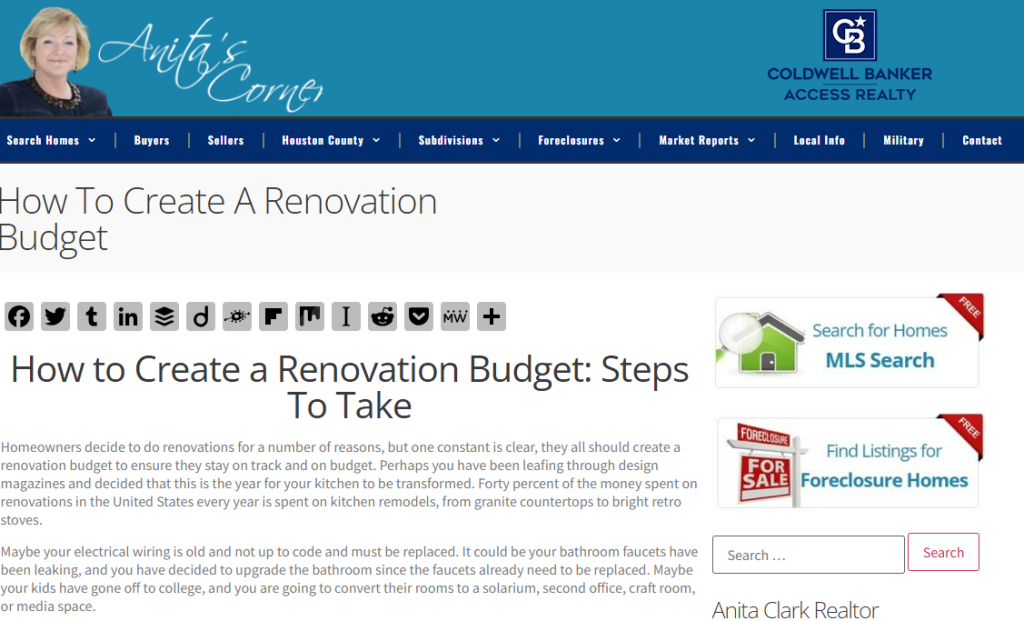
The blog post below by realtor Kyle Hiscock from Rochester Real Estate Blog shares actionable advice about how homeowners can make their properties more energy-efficient:
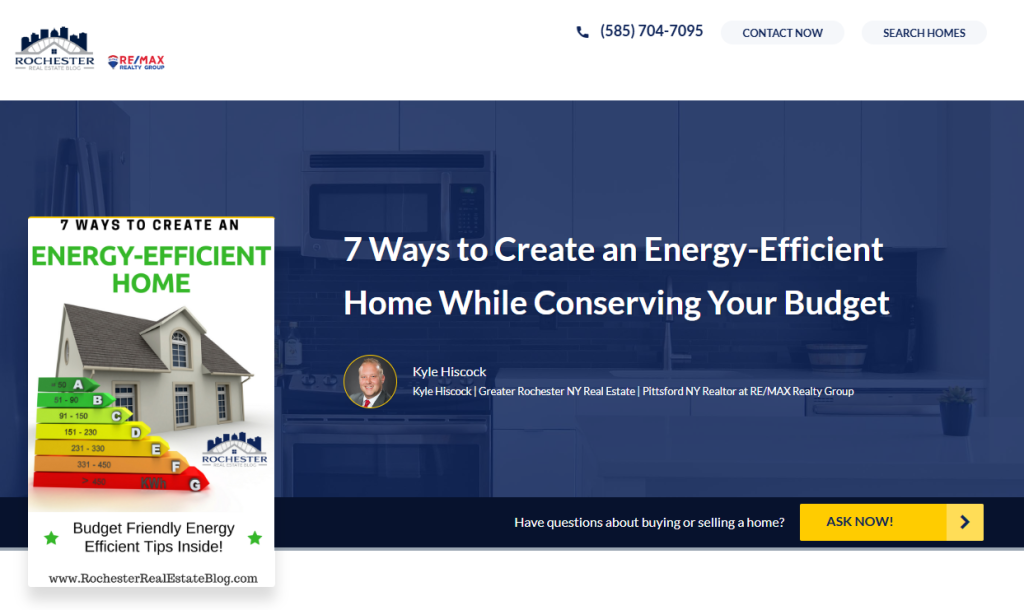
14. Explaining mortgage options for buyers
Mortgages can be complex, and buyers will likely appreciate guidance in understanding their options. This topic could help you clarify the process and gives buyers the details they need to make informed decisions.
Think about covering these points in your post:
- The difference between fixed and adjustable-rate mortgages.
- How to work with a mortgage specialist.
- Federal Housing Administration (FHA) and Department of Veterans Affairs (VA) loans.
- Refinancing options.
- Tips for getting the best rate.
In the blog post below, Malcolm Lawson of the Lawson Group shares how buyers can use a VA loan to purchase a property. He’s included a video at the start of his blog post to make it more engaging and dynamic:


15. How seasonal changes affect the real estate market
Many people aren’t aware that certain times of the year may be better for buying or selling properties. This content shows your expertise and helps real estate clients plan their timing.
You could include:
- Market trends by season.
- Best months to buy or sell.
- Holiday season tips.
- How the weather impacts the real estate market.
In the blog post below, Pink Realty shares how seasonality impacts the real estate market. They unpack the details for each season and explain how readers can navigate these:
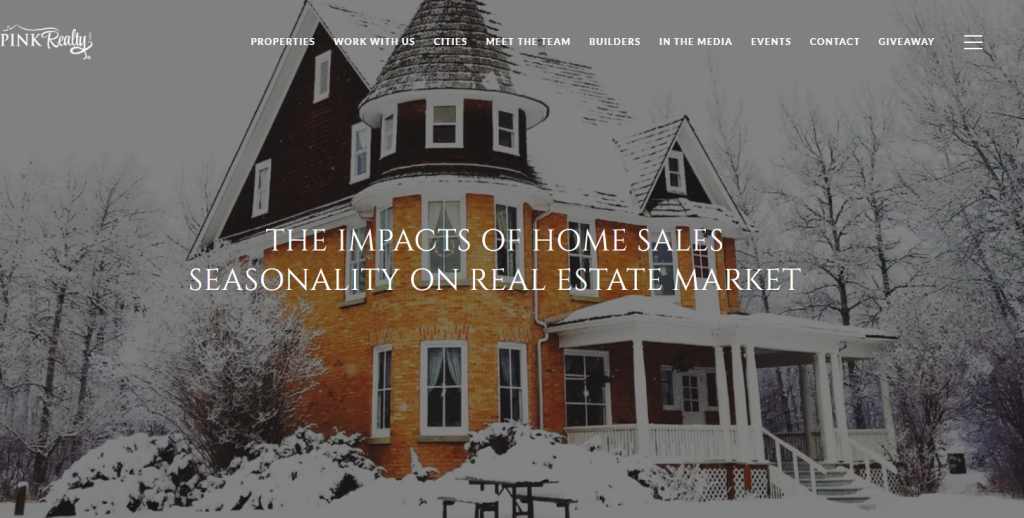
16. A guide to selling a home in a buyer’s market
In a buyer’s market, sellers need to be extra strategic to attract buyers, so you could share a guide that offers insights into navigating a tough market.
Your blog post could cover:
- Competitive pricing strategies.
- Staging and curb appeal.
- Working with agents.
- Negotiation tactics.
Check out this blog post from Tuscana Properties about how to sell a home in a buyer’s market. It explains exactly how selling a home in a buyer’s market would affect sellers and then shares how to stand out in this type of market:

17. The benefits of downsizing
Downsizing is a popular trend among retirees and empty-nesters, so this topic could help your readers understand the advantages and drawbacks.
Consider including:
- Financial savings.
- Maintenance reduction.
- Choosing the right-sized home.
- Tips for decluttering.
The Avenue Stone Real Estate blog post below covers everything readers need to know about downsizing. It includes in-depth insights on the entire downsizing process, helping readers make an informed decision about whether they should downsize:

How Real Estate Professionals Can Get Blogging Right
The average reader only spends around 52 seconds reading a blog post. If you want people to read your entire blog post and convert into new leads, you’ve got to create excellent content. Here’s how to do that:
Understand your target audience and their needs
You can start by identifying who you’re writing for, such as first-time buyers, luxury home buyers, investors, or downsizers. Tailor each blog to these personas, addressing their unique questions, goals, or concerns.
Topics that solve problems are effective because they address immediate needs. Consider what problems or pain points your target audience struggles with the most and turn these into blog posts.
Choose blog topics strategically
You can use SEO tools like Ahrefs to find keywords with good search volume but low competition.
Using real estate keywords in your blog content can drive more traffic to your website and is often highly actionable. Check out our full guide on SEO to learn more about keyword research.
Plan your content calendar
Bloggers who post two to six times weekly are 50% more likely to report strong results, and 44% of people say they typically consume three to five pieces of content before engaging with a business.
You need to develop and publish blog posts regularly to stay ahead of the game and generate leads consistently.
Having a comprehensive content calendar will help you ensure you’re posting regularly and consistently. A calendar also ensures you cover various topics and can plan content around market cycles, holidays, and local events.
Make your content engaging and useful
Here are some ways you can ensure you create engaging and helpful blog content:
- Use clear, simple language: Real estate can be complex, so keep your language clear and accessible. Avoid industry jargon and instead explain key real estate terms in simple language, especially if your audience is first-time buyers.
- Incorporate client stories: Include examples, case studies, and success stories in your blog posts to make your content more relatable and provide real-world examples of your expertise.
- Use expert insights: Over 50% of bloggers use statistics in their blog posts, and 36% include contributor quotes. Including insights like these gives your posts more depth and establishes you as an authority.
In the blog post below, Norada Real Estate Investments uses data and statistics to create an engaging article. They’ve also included some infographics, which makes it visually appealing:

- Include local insights: Focus on neighborhood details, school districts, and market trends to provide area-specific value.
- Provide actionable tips: Offer practical advice that helps your audience rather than focusing purely on generating sales.
- Invite interaction: Encourage comments, questions, and sharing to build a community around your blog.
Ensure your blog posts are skimmable
Over 40% of readers say they skim blog posts rather than read them in full, and the human attention span has decreased from 12 seconds to 8.25 seconds in the last two decades. For this reason, your blog posts need to be skimmable.
Readers should be able to get the gist of what you’re saying by simply scanning the page. Subheadings, bullet points, and infographics can help to make your blog posts skimmable.
Include strong calls to action (CTAs)
After reading your blog post, users need to know what they should do next. A strong CTA encourages them to take the next step, whether scheduling a consultation or downloading a guide.
Place CTAs throughout your blog content and at the end of each post, allowing readers to engage at multiple touchpoints.
Below is a good CTA from a blog post by Rochester Real Estate, encouraging readers to subscribe to their blog:

The same brokerage also gives readers the option to contact them if they’re buying or selling:

Use multimedia to enhance your content
Blog articles with images get 94% more views than those without visual elements, and 43% of consumers expect to see video content from businesses on their blogs, which is 50 times more likely to drive organic search traffic than plain text.
Here are some visual elements you should consider adding to your blog posts:
- Video content: Short, informative videos can add depth to topics. For example, a blog on home staging could include a short video tour of a staged home.
- Interactive elements: Tools like mortgage calculators, interactive neighborhood maps, or image sliders for “before and after” professional real estate photography make content more engaging.
- Photos: Including photos of local neighborhoods, schools, parks, and landmarks reinforces your knowledge of the area and makes your blog more visually appealing.
This blog post about purchasing investment properties with a VA loan includes informative videos throughout to break up the text and provide added value for the reader:

Promote your content across multiple channels
Over 95% of bloggers promote their blog posts via social media, and you should do the same. Every blog post can be shared on social platforms, where you can highlight key takeaways or use visuals to make your posts more appealing.
In the Pinterest post below, realtor Christina Beckwith uses a visual to share her blog post on the home-selling process. Viewers can follow the link to read the full blog post:

As mentioned earlier, you can include blog posts in your email newsletters or create “best of” lists around relevant themes. For example, send a “Top 5 Blogs for First-Time Homebuyers” to subscribers who have expressed interest in buying.
Mistakes to Avoid on Your Real Estate Blog
There are some common mistakes that real estate service providers make that can limit their blog’s reach, engagement, and overall effectiveness. They include:
An inconsistent posting schedule
Over 40% of bloggers publish new content between three and six times monthly, and consistent blogging generates more leads and helps them to stay relevant.
Sporadically posting content, like publishing several posts in one month and then nothing for months, can disrupt audience engagement and reduce SEO benefits.
Regular posting keeps readers coming back, shows that your blog is active, and signals to search engines that your site is updated.
Focusing only on property listings
Using your blog solely to showcase property listings can be off-putting for readers, as they may see it as an extension of your listing page rather than an informative resource.
Readers are more likely to engage if you provide educational and valuable content that goes beyond listings.
Writing content that is too technical or jargon-heavy
As mentioned earlier, using industry jargon or technical terms can make content difficult for users to read and understand, especially for first-time buyers or sellers.
Clear, accessible language builds trust and engages a broader audience. Rather than using terms like “FHA” or “amortization,” explain these concepts in simple terms or provide short definitions. Consider using your blog as an opportunity to educate without overwhelming readers.
Neglecting visual content
Not including images, infographics, or videos can make a blog feel dry or text-heavy, limiting its appeal to readers.
As mentioned earlier, visual content captures attention, enhances understanding, and makes your blog posts more engaging.
Ensure you include high-quality images, videos of local tours or tips, or infographics for market trends to break up your text and add visual interest.
Not including CTAs
Many real estate blogs lack CTAs that guide readers on what to do next. CTAs convert blog visitors into potential leads by prompting them to engage further. Including CTAs that align with your content makes it easy for readers to take the next step.
Overlooking analytics and performance tracking
Not monitoring your blog’s performance can lead to missed insights into which content is most effective or where your strategy needs to be adjusted.
Analyzing metrics like page views, average time on page, and conversion rates helps identify successful topics and areas to refine.
Tools like Google Analytics or social media insights can guide future content strategies by revealing what resonates with your audience.
Ignoring mobile optimization
Over 60% of website traffic comes from mobile devices, and if your blog isn’t optimized for mobile, it won’t display correctly on smaller screens. Also, more than half of consumers will stop reading a page if they encounter issues viewing content.
You must ensure that your blog post layout, images, and CTAs work seamlessly on mobile to enhance the user experience and improve your search rankings, as Google prioritizes mobile-friendly sites.
Failing to update older content
Only 38% of bloggers invest time in updating older articles. Ignoring older blog posts can lead to outdated and irrelevant information being available on your website, which is problematic in real estate as markets change and evolve rapidly.
Updating older blog content with current data, new photos, or refreshed CTAs keeps your blog accurate and can boost its SEO value. Regular updates to high-traffic posts help to keep the content relevant and maintain reader trust.
How to Find Time to Focus on Blogging with Paperless Pipeline
Regular blogging can help you generate more leads, establish you as an industry expert, and educate and retain clients. However, regular blogging can take up a lot of time and resources.
How do you manage consistent blogging if a complex transaction management process bogs you down?
This is where Paperless Pipeline, a purpose-built transaction management platform, can help. Our software automates the entire transaction process, from listing to closing, giving you more time to focus on high-impact activities like blogging.
With our solution, you’ll never miss a critical due date or milestone, and everyone on your team will be on the same page at all times. This ensures all your deals run smoothly and close on time.
Visit our website for a free 14-day full-feature Paperless Pipeline trial to see if our transaction management software is the right solution for your brokerage.